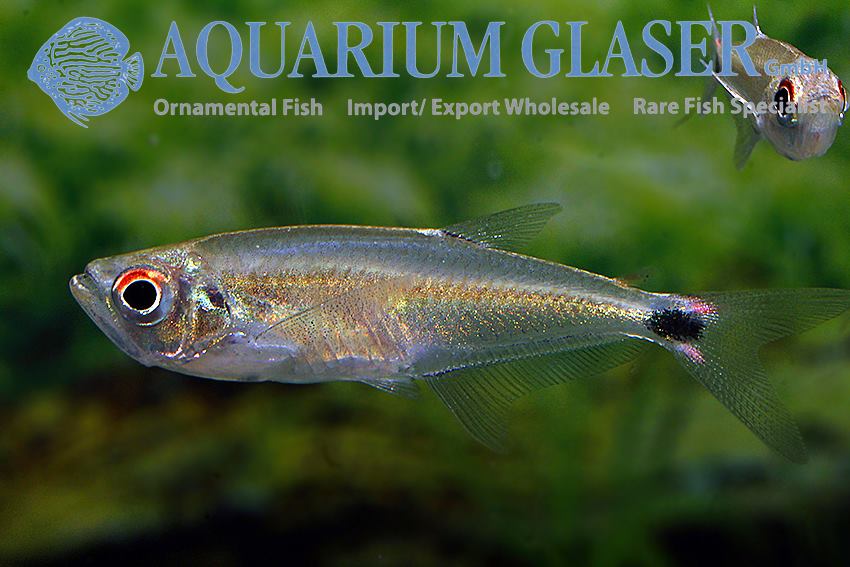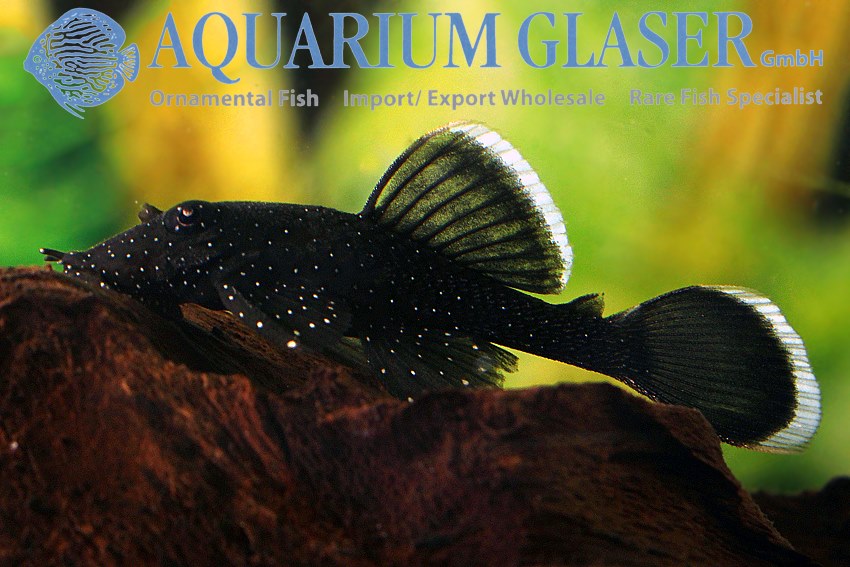
As each month we present the most popular fish imports sponsored by Aquarium Glaser!
Gnathocharax steindachneri
In the natural habitat of the cardinal tetra food sources are very scarce. So it is really astonishing how many species can exist there. However, many of them stay very small. Good luck for the aquarium hobby, for they all make very good ornamental species!
Even a predatory species of that biotope is such a dwarf: Gnathocharax steindachneri. It attains a maximum length of only 5 cm and belongs to the closer relationship to the freshwater barracudas (Acestrorhynchus), what is clearly visibly by the structure of the fangs and teeth. However, Gnathocharax is not dangerous for other fishes larger than approx. 1 cm. Most probably the species feeds on fish and insect larvae in the wild.
Currently we were able once more to import this most interesting species of tetra. It is perfectly suitable for community tanks with cardinals and other tetras. Here Gnathocharax loves to swim along with conspecifics in the upper third of the water column. The fish feed readily on any type of usual fish food, even dry food is taken from the very first day on, despite the specialized dentition.

White Seam Ancistrus
There is more than one species of Ancistrus with a white seam in the dorsal and the caudal fins. A. dolichopterus ( = L183) can usually easily recognized by the fact that it has 9 soft rays in the dorsal fin (all other similar Ancistrus have 7-8). Only very occasionally individuals of A. dolichopterus with less than 9 soft rays in the dorsal fin occur. The coloration is no good determination feature, for juveniles look different than adults and Ancistrus can change their colours also mood-dependent quite quick.
Before it was found that L183 is the „real“ Ancistrus dolichopterus, L183/White Seam Ancistrus was wrongly determined as Ancistrus hoplogenys. However, today we know that Ancistrus hoplogenys is identical with L59, which has orange seams on the dorsal fin. There is another species of Ancistrus which is repeatedly confused with Ancistrus dolichopterus, L183/White Seam Ancistrus. This species obtained several L-numbers: L71, L181 and L249. However, all these L-numbers represent the same species. It was given the common name “false hoplogenys”, because only the small juveniles have the pretty white seams, in contrast to the “true hoplogenys” (which is Ancistrus dolichopterus, L183/White Seam Ancistrus) which has these white seams the whole life through. In “L71, L181 and L249” these white seams disappear in elder fish. Sadly both forms are not distinguished in Brazil. So even we never know what we will get when we order small White Seam Ancistrus from Brazil.
Sadly this mess in names still persists.
Channa sp. Meghalaya
Currently is the season for species of Channa from India. Every now and then we can offer the gorgeous Channa pardalis, which is also known in the hobby under the name of „True Blue“. There is a second, very similar Channa, traded under the name of Channa sp. Meghalaya. There is a rumour among the Channa freaks that this should represent a second, valid species of Channa, already under scientific description. The main differences between the True Blue and Meghalaya are said to be the lack of black spots in the face of the Meghalaya and the presence of a bright orange zone in front of the eye of Meghalaya.
Currently we have both Channa in stock, a good opportunity to take a closer look on them. So I picked up the largest (14-15 cm) pair of C. sp. Meghalaya (at least the male is for sure a male) and the smallest individual and photographed them. The female fits perfectly to the differences described above: no black spots in the face and a bright orange zone in front of the eye. The male fits not as good. The black spots are also lacking, but there is not the slightest sign of an orange zone in front of the eye. The halfgrown young adult has so many black spots in the face that I thought a C. pardalis would have been placed erroneously in the tank of the C. sp. Meghalaya – but then I spotted the bright orange zone in front of the eye…
So – as a conclusion: there are no constant differences in respect of head coloration between Channa pardalis (True Blue) and C. sp. Meghalaya. One should keep and breed them separately, but there are in no way clear specific differences.
Myxocyprinus asiaticus
We have the Chinese High Fin Loach, sometimes called the Batman-Loach, almost anytime in stock. Sadly the species is in danger of extinction in the wild, mainly due to hydroelectric power stations. All specimens traded come from aquaculture and are bred in captivity.
Usually we get the fish from Singapore, but as a test we ordered some from a new supplier from Hongkong now. Of course we observed these fish very carefully and found that there are two different phenotypes. Some specimens are reddish and the mighty dorsal fin is rounded at its tip. Others are rather black-and-white and the dorsal fin of these fish is much more pointed. Both phenotypes can be found in fish of the same size, the photographed ones are both 10-12 cm long. Do these differences in coloration represent the different sexes? That would be astonishing, as all highfin loaches in the trade are still small juveniles. This fish can attain a maximum length of about 1.2 metres and a weight of about 23 kg; the adults look totally different, too.
Well, we will see. We will put the two photo models in a 5.000 liter tank and see how they develop.
Due to their maximum size only juveniles can be kept in normal sized home aquaria. Later the fish have to move in really big tanks or garden ponds. The species is winter-hardy in central Europe. They are much sought for to be kept along with koi carps, for Myxocyprinus is an algae eater and helps to keep the pond clean.
Marbled Dwarf Ghosts
The most important species New World Knifefishes or Ghosts in the ornamental fish trade are without any doubt the Black Ghost (Apteronotus albifrons) and the Brown Ghost (A. leptorhynchus). We have both species in stock on a regular basis, the Black Ghost both as wild collected from Colombia / Venezuela and bred ones, the Brown Ghost wild collected from Colombia/Venezuela.
Now we have a third species from Venezuela in stock, which is currently only rarely available, but which has the potential to compete with the two species mentioned already: the Marbled Dwarf Ghost, Adontosternarchus clarkae. This pretty species is as fascinating as the Apteronotus species, eg the special way of swimming in all directions that reminds the observer in watching a underwater ballet, but has the advantage that is grows only to a maximum length of about 20 cm; the most specimens stay much smaller. In contrast to that, A. albifrons, attains a length of 50 cm and A. leptorhynchus of 30 cm.
Against tankmates, may they belong to the same or to different species, A. clarkae are completely peaceful. They need hiding places and a well structured aquarium. Bloodworm is the food they like most, but the fish also take readily any other type of live, frozen or granulated fishfood. One should take care that the ghosts get enough food, for especially during acclimatisation the fish are preferably crepuscular.
The fish are totally undemanding regarding water chemistry. The water temperature should be between 24 and 28°C.

Hemigrammus coeruleus
Among the most sought after species of tetra is Hemigrammus coeruleus. The species attains a maximum length of about 6 cm and look even pretty in the regular coloration – a bit similar to the well known glowlight tetra (Hemigrammus erythrozonus). But when the fish come in breeding mood, they look really spectacular! The males become so deeply red that one might think to see a different species! Sadly the fish is hardly available as wild collected ones. We recently obtained only 5 specimens! But we expect in the very near future a good number of German bred ones.
Anzeige














































